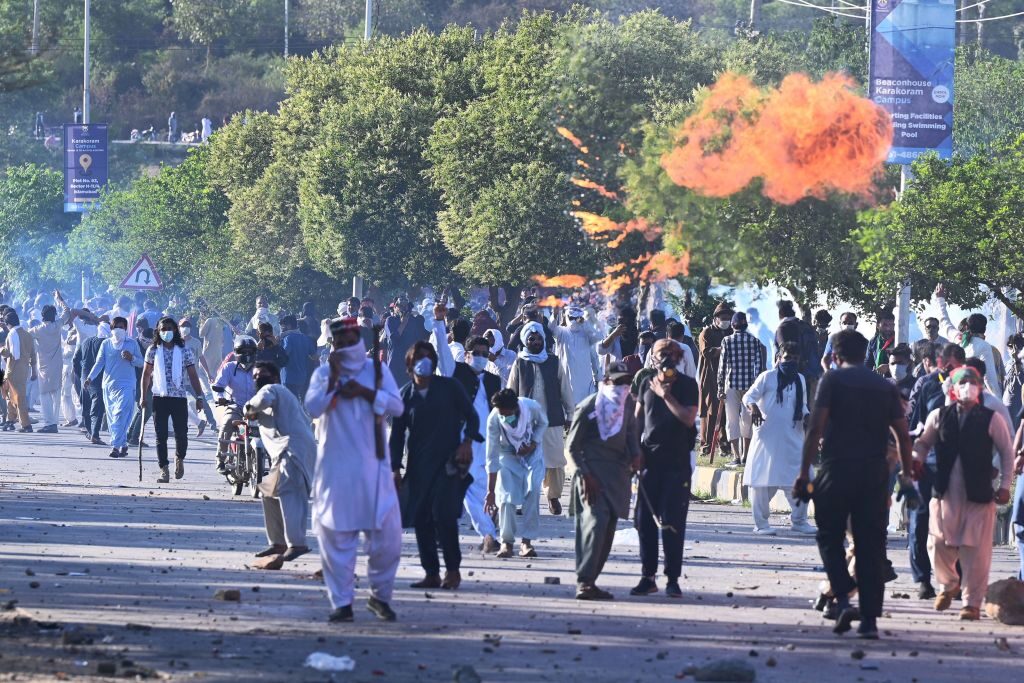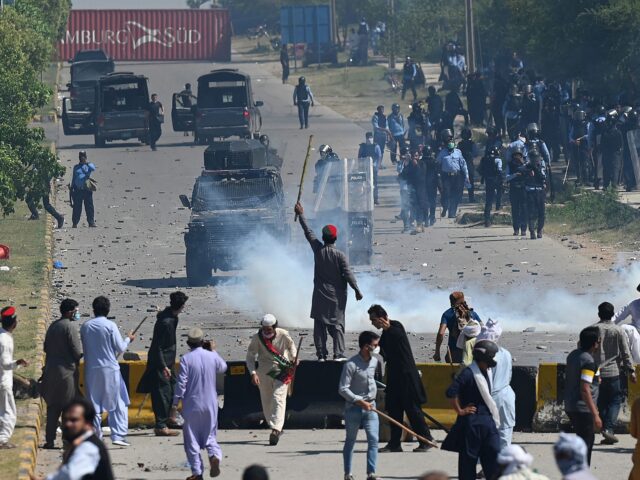Journalists in Pakistan reported at least six deaths and ongoing, massive destruction of property nationwide on Wednesday in nearly every major city following the arrest of radical Islamist former Prime Minister Imran Khan the day before.
Khan, who is facing charges of mishandling foreign gifts while in charge of the government alongside other corruption accusations, is by far the most popular politician in the country.
The firm Gallup found Khan enjoying a 61-percent approval rating in its latest national poll, a significant lead over the country’s second-most popular politician, former Prime Minister Nawaz Sharif, with 36 percent approval.

Pakistan Tehreek-e-Insaf (PTI) party activists and supporters of former Pakistan’s Prime Minister Imran clash police during a protest outside the police headquarter where Khan is in custody, in Islamabad on May 10, 2023. (FAROOQ NAEEM/AFP via Getty Images)
Nawaz Sharif is the brother of current Prime Minister Shehbaz Sharif, who took over after the nation’s Parliament ousted Khan in a vote of no confidence – by lawmakers, not the general public – last year.
Khan has spent the past year organizing his Pakistan Tehreek-e-Insaf (PTI) political party to campaign for a return to power, forcing elections in regions where the PTI is most popular. He survived an assassination attempt in November, getting shot in the leg, that managed to keep the 70-year-old off of a stage for less than a day.
Khan blamed Shehbaz Sharif for the attempt on his life and has repeatedly told supporters the ruling party wants to kill him. Following his arrest on Tuesday, Khan told the court processing his case that he feared for his life in police custody.
“They give [you] an injection, and [you] slowly die,” he claimed, demanding only his personal doctor tend to him.
In addition to Khan fueling fears that the government may kill him, the PTI has been calling for supporters to assemble and demand his liberation. On Tuesday, the PTI shared videos of thousands of men – Khan’s followers, radical Islamists, who appear in public tend to be exclusively men – storming the streets of 18 cities across Pakistan. The federal government has since shut down access indefinitely to the internet nationwide to prevent the PTI from organizing riots via social media.
According to the Pakistani newspaper Dawn, the cities that experienced the most violent riots were the capital, Islamabad, as well as Karachi, Lahore, Peshawar, Faisalabad, Quetta, and Rawalpindi, among others. Dawn reported local authorities confirming three people dead in Peshawar. India’s World Is One News (WION) reported two others dead in Faisalabad as of Wednesday. The Pakistan Express Tribune reported one death in Quetta as a result of a “firing incident,” identified as an unnamed PTI worker.
Also as of Wednesday, Dawn reported that police had arrested over 1,000 people nationwide in response to the unrest.
Widespread reports and videos shared on social media prior to the Pakistani government shutting down the internet show mobs burning buses and ambulances, attempting to burn down police stations and the homes of military leaders, and tearing down the offices of local media outlets. Both police officers and rioters appear to be armed, shooting at each other in street battles, in addition to rioters using rocks and clubs to attack police officers. Police also claimed that PTI supporters used Molotov cocktails to attack police and destroy buildings.
In Rawalpindi, rioters stormed the headquarters of the Pakistani Army.
“In Rawalpindi and Islamabad, violent confrontations between the police and PTI supporters were witnessed followed by a crackdown on party supporters. In Rawalpindi, sensitive installations, including GHQ and Hamza Camp (Ojhri Camp), were targeted by the PTI supporters,” Dawn detailed. “Two police officials –Waris Khan DSP Tahir Sikandar and Ratta Amral SHO Chaudhry Riaz were also injured in an altercation with the PTI workers. The metro bus service was also suspended between the two cities.”
Rioters in Lahore attempted to storm the home of the local military commander, throwing stones and burning down parts of the home.
“The protesters broke the main gate of the corps commander’s house while chanting slogans against the arrest of their chairman. Video footage circulating on social media showed workers breaking windowpanes, TVs and furniture of the house, and also setting trees and furniture on fire,” Dawn reported.
The Express Tribune described scenes of chaos in Quetta where rioters burned two police cars, blocked highways, and stoned police officers.
In Peshawar, rioters reportedly burned an ambulance and burned down the office of the Associated Press of Pakistan.
Karachi’s Sharea Faisal, a main thoroughfare, became the venue of a “three-hour-long face-off between police and the protesters” in which the rioters engage in open battle with law enforcement, destroying a dozen vehicles and burning down police checkpoints set up in an attempt to maintain order.
“As the workers marched on Sharea Faisal suspending traffic on the key road link, the police resorted to baton-charge and teargas shelling which attracted a strong reaction from the protests,” Dawn narrated. “In a three-hour-long face-off between police and the protesters, over a dozen vehicles, including a police van, and two check posts each of the Karachi police and Pakistan Rangers were set on fire.”
Police reportedly responded with tear gas and unspecified “shelling,” which Dawn reported was so intense that it injured trapped civilians in office building lining Sharea Faisal.
Violence continued into Wednesday. Islamabad police confirmed with photo evidence that rioters had burned down a police station in the capital.
“We were peaceful and calm,” PTI MPA and deputy information secretary of Sindh chapter Shahzad Qureshi told Dawn. Karachi is the regional capital of Sindh.
“We only stopped traffic for a while to register the protest,” Qureshi claimed. “After that we only held a march along the road without disturbing the traffic but from nowhere the police resorted to teargas shelling leaving scores of our workers injured and unconscious. It’s nothing but fascism.”

COMMENTS
Please let us know if you're having issues with commenting.